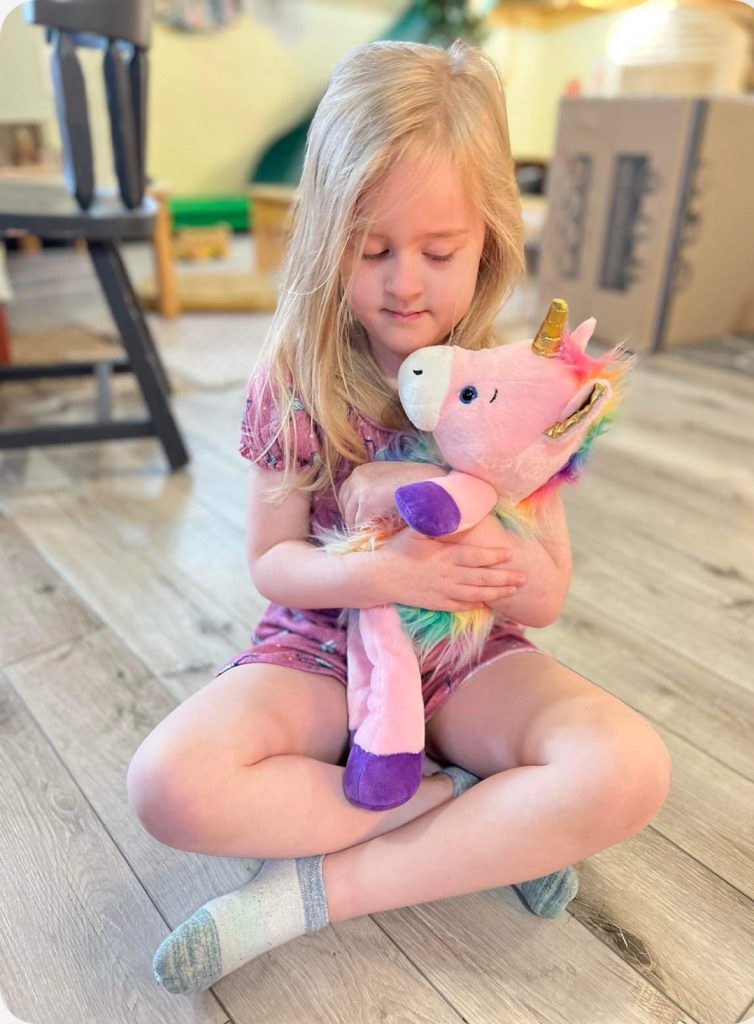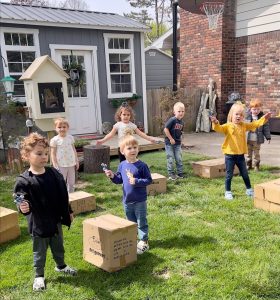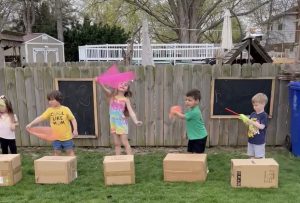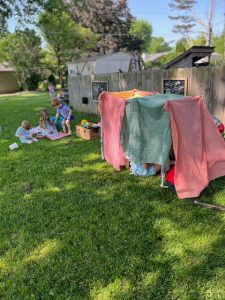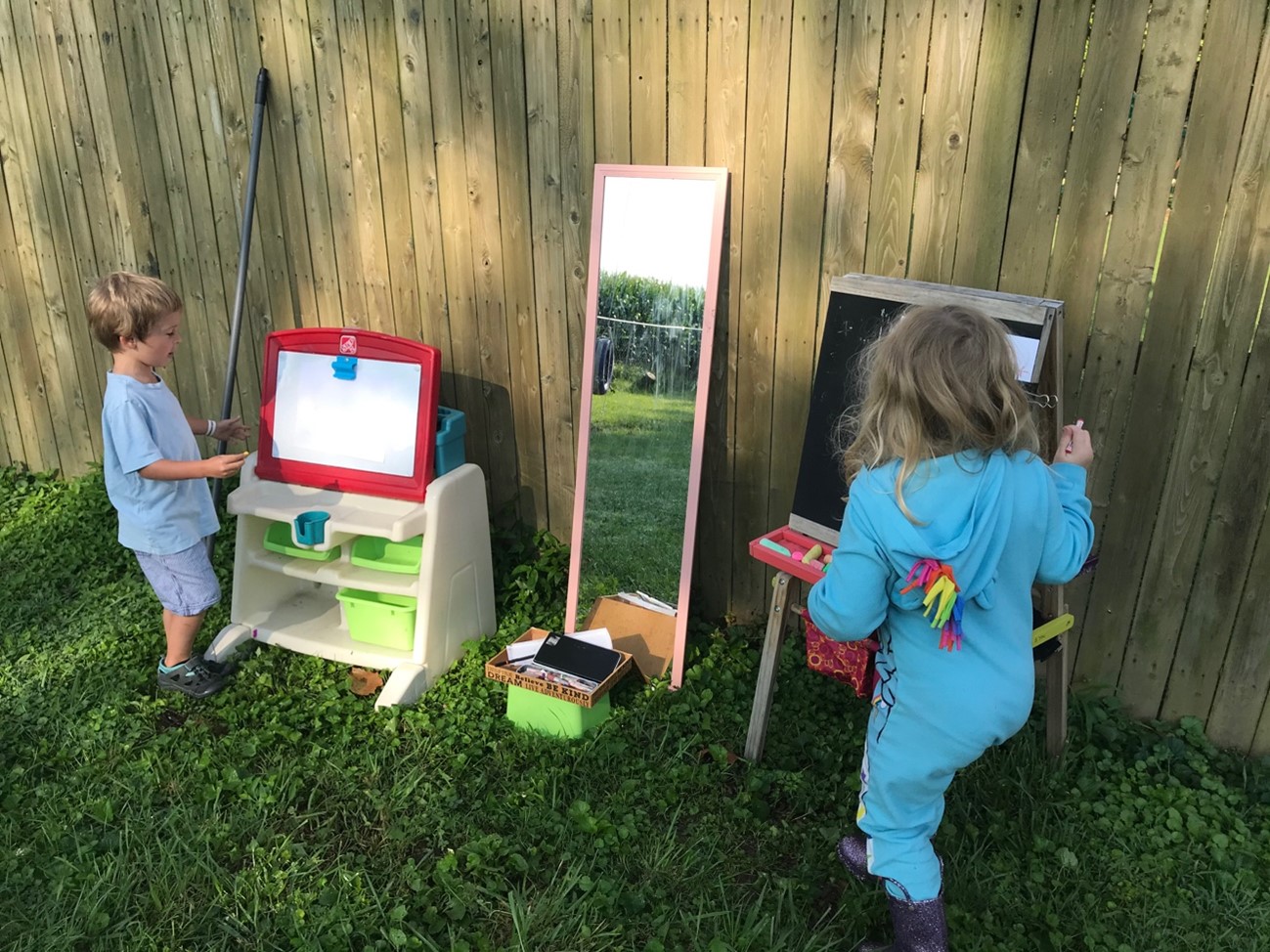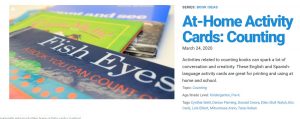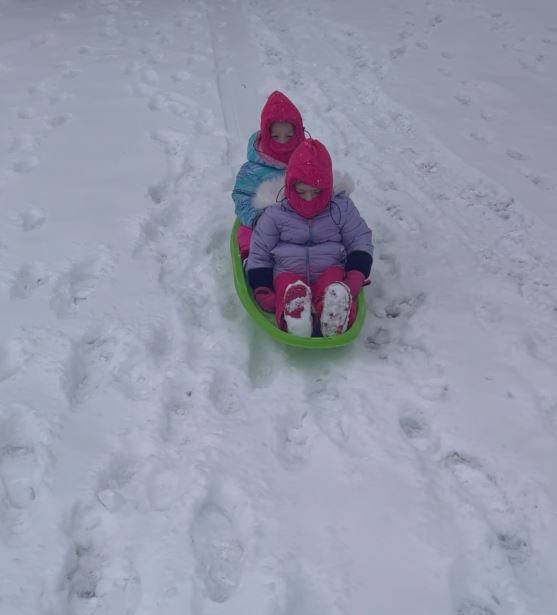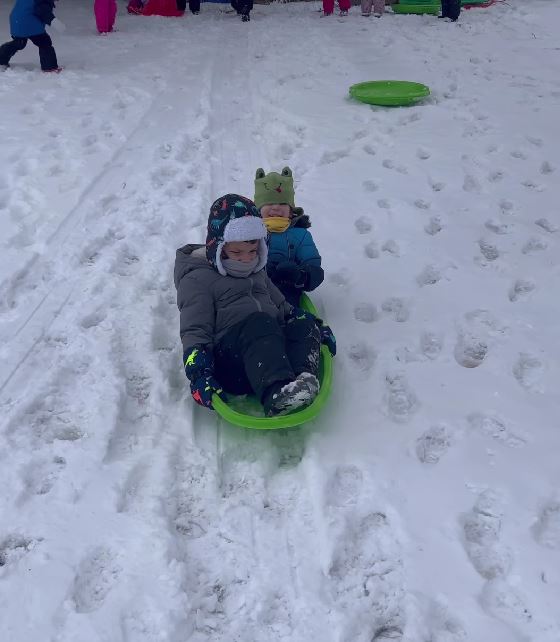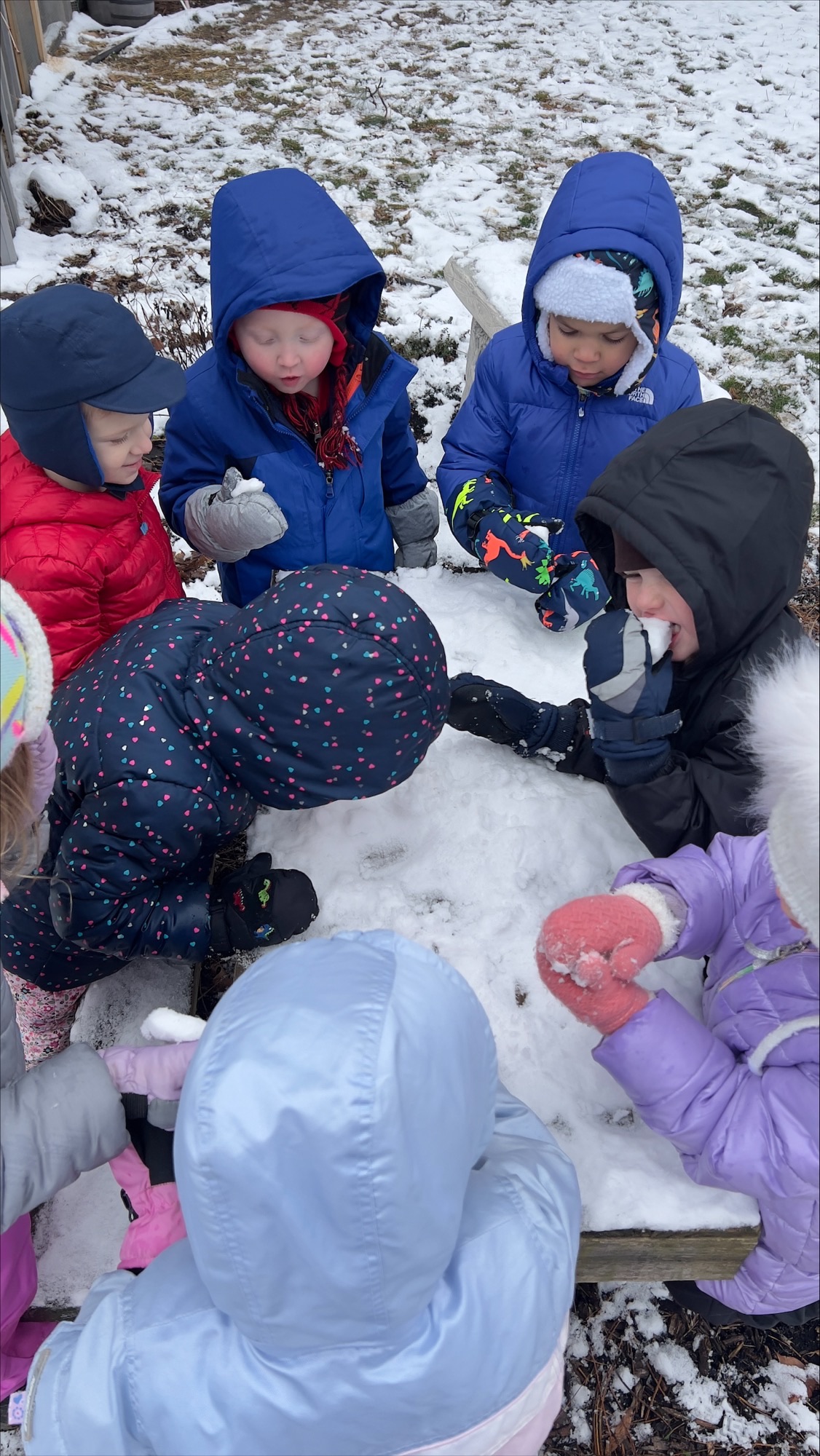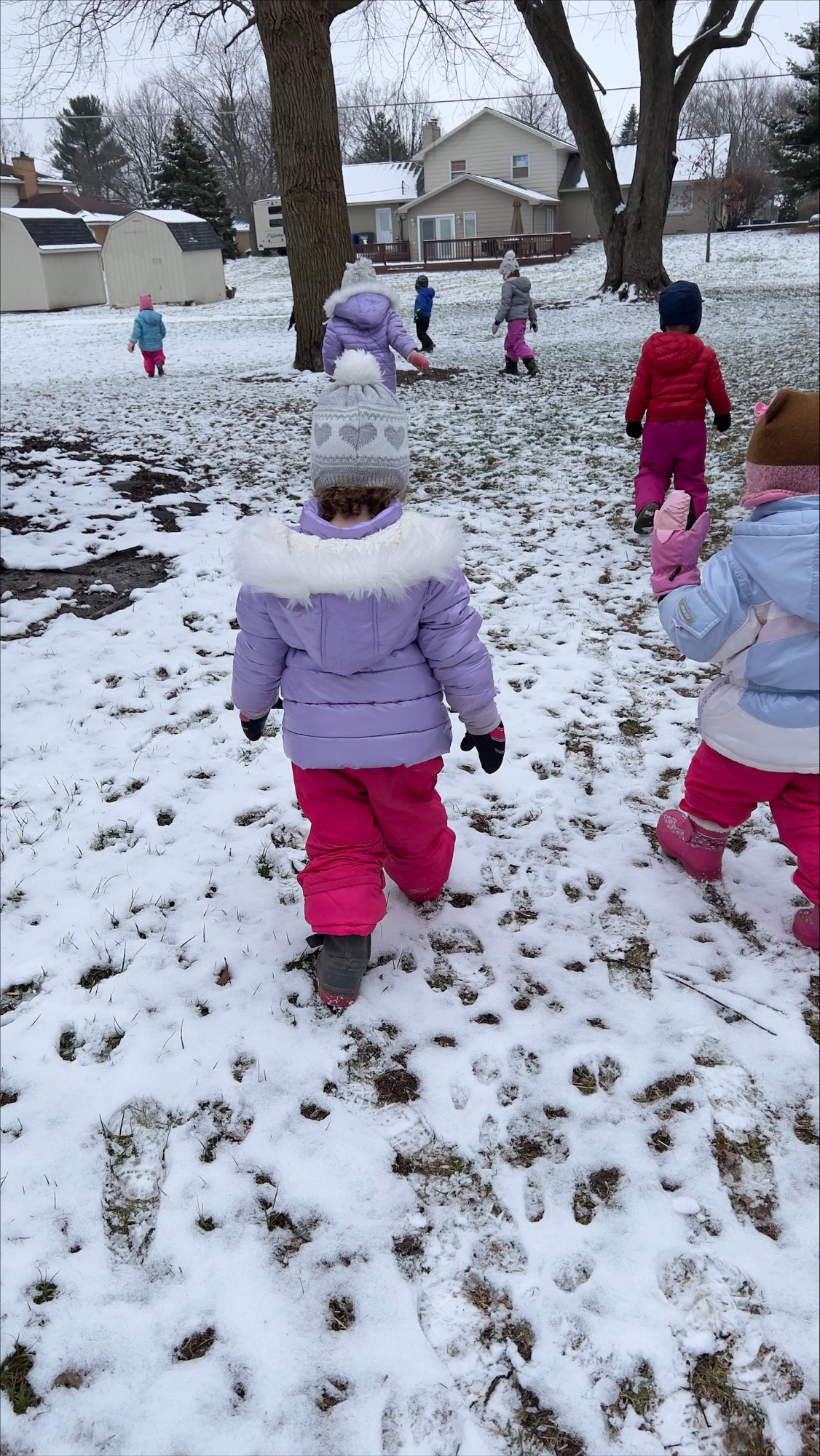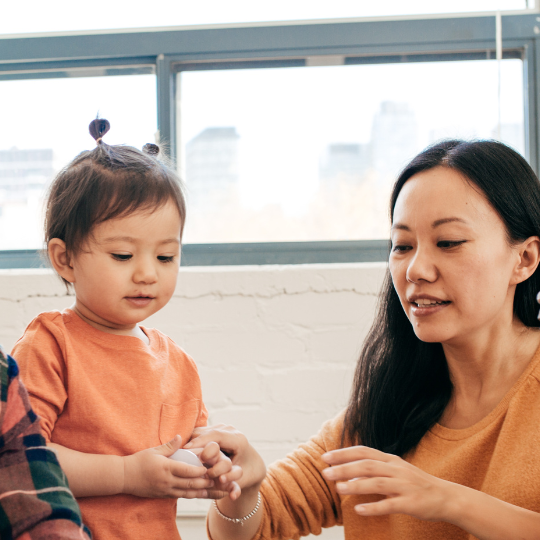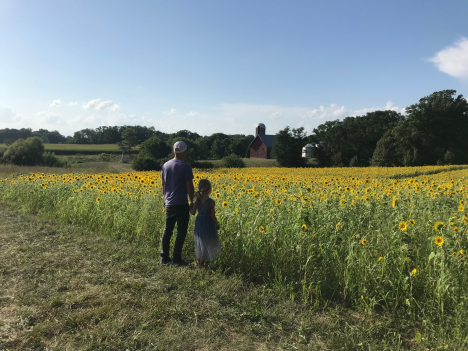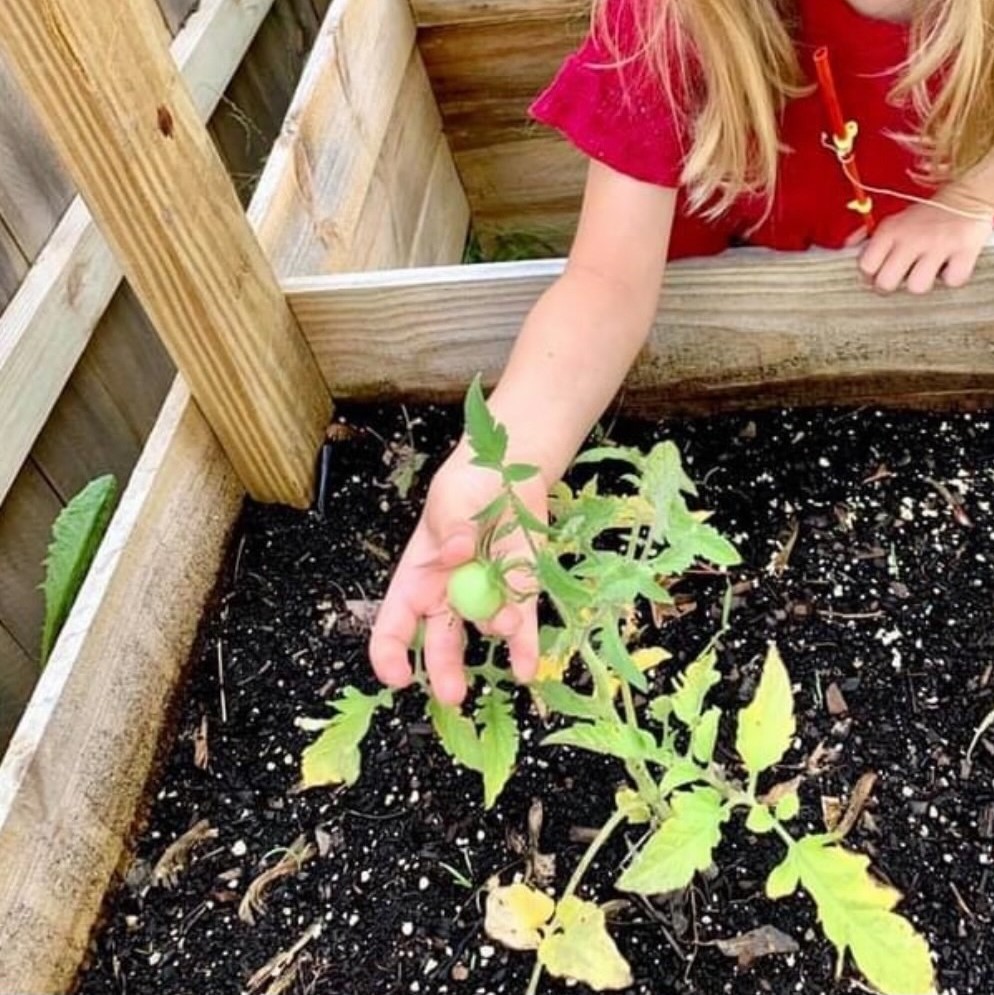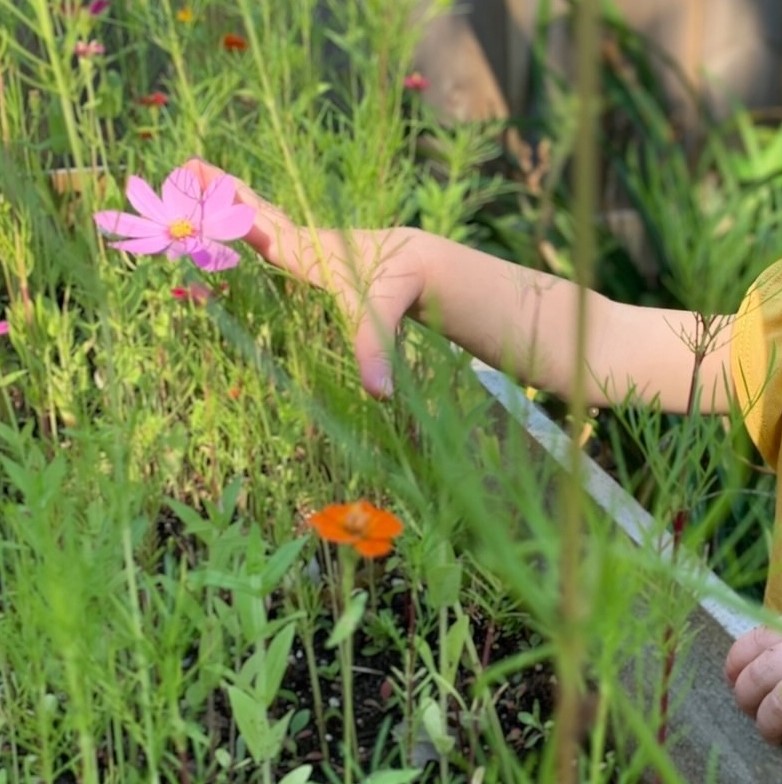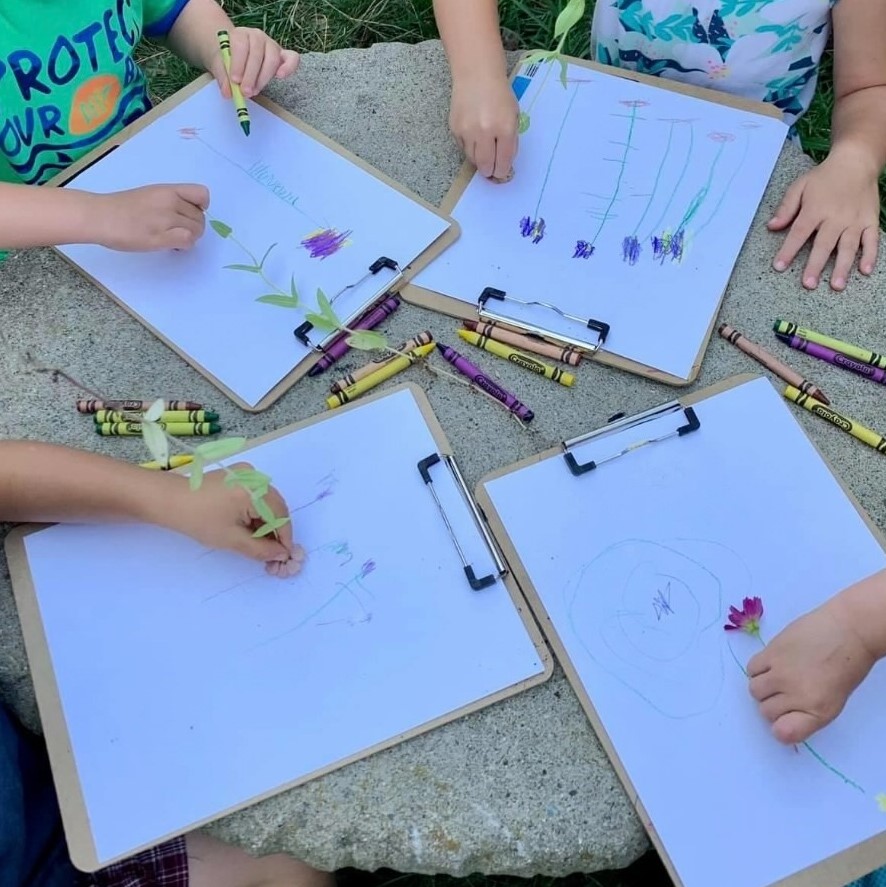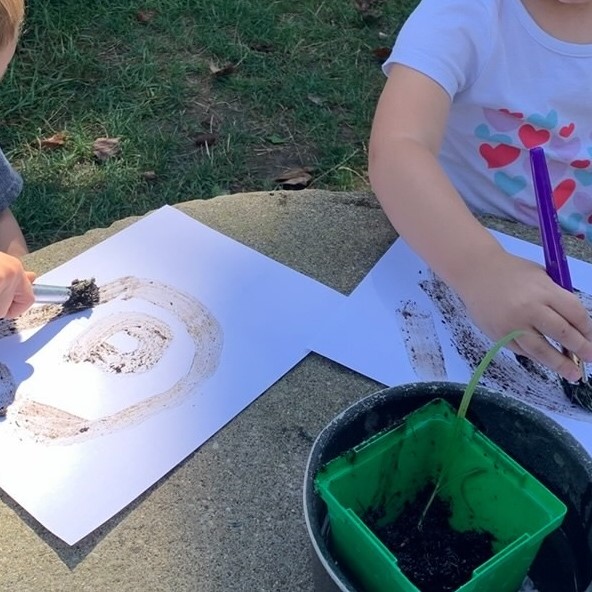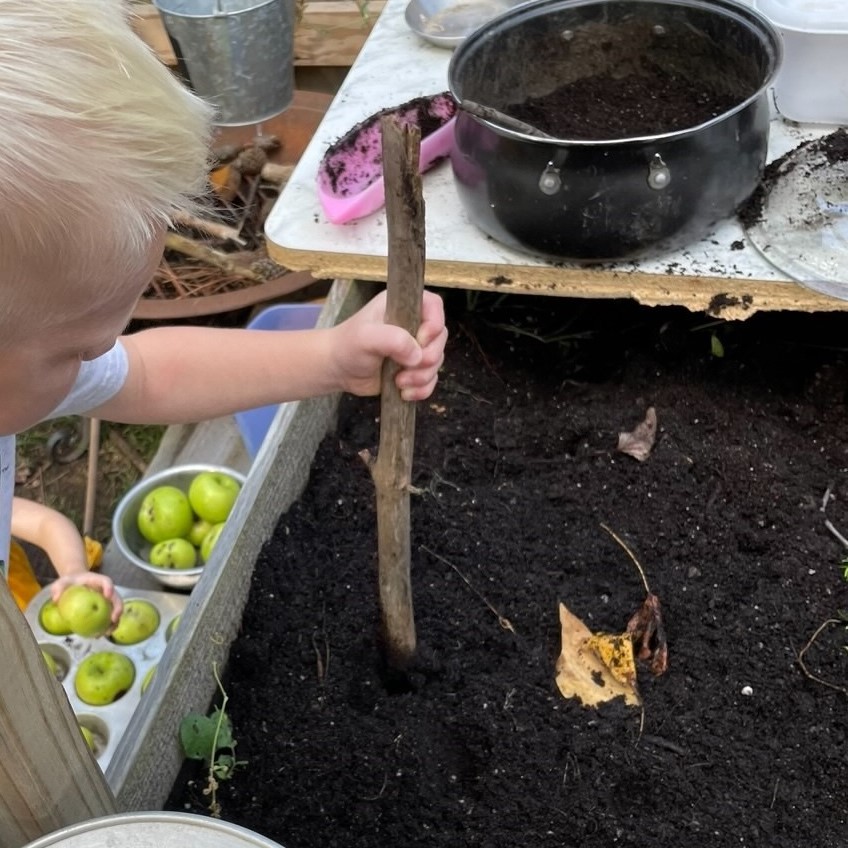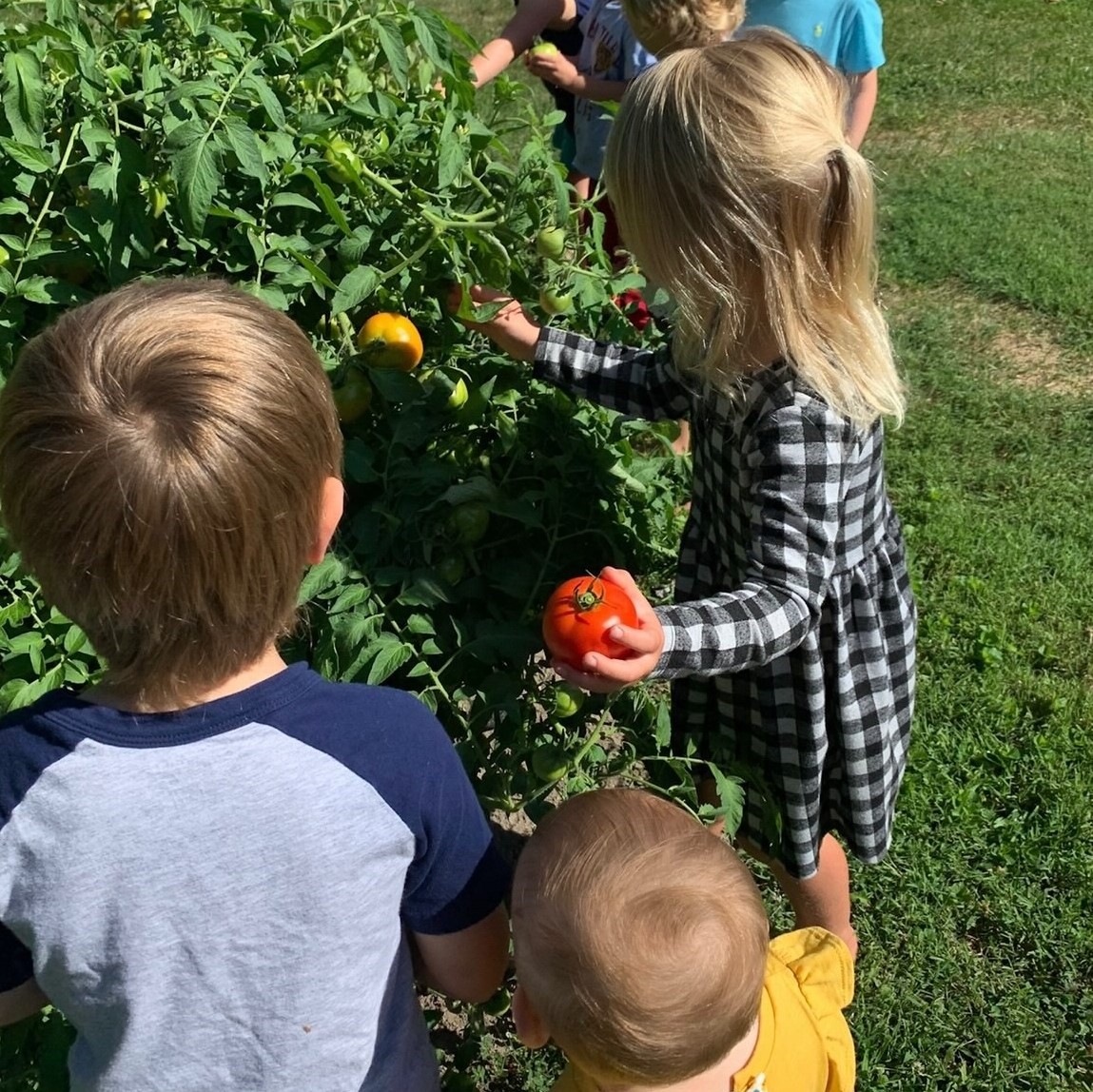Como parte de nuestro plan de estudios de aprendizaje socioemocional, leemos un cuento sobre un concepto socioemocional diferente utilizando la vista, el tacto y el sonido para implicar a los niños y solidificar el proceso de desarrollo de habilidades.
Siempre incorporo un peluche que se correlaciona con una necesidad social o emocional diferente.Por ejemplo, los unicornios para la creatividad, los osos para sentir amor, los perezosos para frenar, el caracol para sentirse valiente. Mi objetivo es contarles una historia o leerles un libro que encuentre sobre ese objetivo socioemocional y pasarles el peluche y ayudarles a creer en sí mismos y en sus capacidades.Para recordarles que podemos superar los momentos difíciles, y que no tenemos que hacerlo solos.
Diariamente trabajamos las afirmaciones positivas y la idea de que sus opiniones sobre sí mismos importan. También hemos hablado de cómo manejar situaciones difíciles y de cuándo pedir ayuda. Como profesora, hago todo lo que está en mi mano para ayudar a guiar a niños amables, empáticos y fuertes.
El aprendizaje socioemocional consiste en inculcar a nuestros hijos sentimientos de autoestima. Utilizamos afirmaciones en respuesta a muchas situaciones, como las necesidades de resolución de conflictos, las necesidades de autoestima y las necesidades de regulación emocional, por nombrar algunas. Y usando afirmaciones a diario noto que los niños sacan este tipo de dichos positivos por su cuenta, sin que yo se lo indique.
Las habilidades específicas que aprenden los niños incluyen
- Interacción: contacto físico, contacto visual y juegos
- Conexión – leer afirmaciones positivas y hacer que te las repitan (si es posible)
- Reflexión – practicar los conceptos y habilidades aprendidos
Como profesores, honramos la vida emocional de los niños y les permitimos encontrar las palabras para expresarse mientras se enfrentan a sus complejos sentimientos.
Bringing or building musical instruments outside can be a great way for children to practice coordination, creativity, rhythms, and tones in a setting that allows them to create a great range of auditory experiences.
To deepen children’s thinking, encourage them to hit different parts of their drum with the stick to see if the sound changes; note when they make louder/softer sounds, and how the achieved it; and help them to create and test hypotheses about how changing their instrument will change the effect (i.e. what would happen if you put a leaf on your drum, and hit that with the drum stick?). By exploring these different traits of the music they create, children are learning about differences in tone and volume, two important concepts within musicianship. As they drum and dance, they are also practicing bilateral coordination (moving both sides of their bodies at the same time), a big skill for pre-writing.
Your instruments don’t need to be complicated. Some boxes and sticks can go a long way! Consider also including recycled cans (with sharp edges covered!), making shakers from water bottles and beads, or wooden spoons —see LOTS more ideas for a variety of ages here.
Fort building is an activity most children enjoy– who wouldn’t love the opportunity to be the architect of their own space? It’s also an incredible way to promote children’s creativity, imagination, persistence, and STEAM skills.
Why is this a STEAM activity?
Science: children need to navigate the physical properties of a variety of materials to make their fort. Will the fabric keep its shape when draped over sticks, or will it fold in ways the children didn’t anticipate? Will rubber bands be strong enough to hold the sticks together, or will they need to use yarn or glue?
Technology: Older children can use rulers, measuring tape, levels, and more tools to help them plan and execute their forts.
Engineering: Structural engineers need to take into account the materials they’re working with when designing structures for an intended purpose. These young engineers will learn the foundational problem-solving skills when the plan and test their designs.
Art: A sense of aesthetics is crucial in fort design! Children can select their color scheme and decor as they assemble.
Math: Geometry is key here, as children figure out how large a space they need to fit the people they would like inside, and measure their sticks and cloth accordingly.
Building outdoor fabric forts promotes play can help children develop problem-solving skills that will help them later in life. Fabric forts don’t always work out the way kids want them to! They teach children to find new and better ways to achieve the result they want.
How can you get started? Depending on the ages of the children involved, this activity may use: blankets, tablecloths, sticks, lengths of PVC pipe, yarn, glue, paper, rubber bands, and all kinds of other “stuff” that you have on hand!
Bring the mirrors outdoors and enjoy this simple and rewarding activity! During the early years, children are enamored with their own reflections. Providing this opportunity to study themselves, and create art, encompasses many different skill sets for young children.
Infants: Infants will enjoy simply looking at themselves in a mirror. Offer a hand mirror on a blanket where they can gaze and practice tummy time!
Toddlers: Help toddlers label their own features in the mirror. Encourage them to explore different art materials without concern about the final product. Focus on correctly holding utensils (pencil between fore finger and thumb).
Older Toddlers: Encourage older toddlers to recognize simple shapes in their features and transcribe those shapes on their drawing. Encourage correct handling of utensils, and help children write their names.
Pre-K: Encourage children to write their names and label their features when finished with their portraits.
Have you tried self portraits in your program? Have a fun activity? Share it with us info@townsquare.org
Early Math Collaborative is a part of Erikson institute dedicated to providing math resources and professional development for educators and administrators.
The collaborative recently launched Download format; making resources available for immediately download and printable for everyone.
Enjoy these at-home activities cards to help children explore numbers, shapes, sorting and more!
At-home activities cards are available in English and Spanish
For many of us, winter is sticking around for a few more weeks, which means more fun in the snow. Remember, there is no such thing as bad weather; there is just bad clothing.
Playing outside during cold weather is very beneficial for children.
It builds resilience, helping children learn to cope with uncomfortable or challenging situations, and builds mental and emotional strength.
It improves creativity and imagination; being outside provides endless imaginative play and exploration opportunities.
It promotes physical activity, playing in the snow, and engaging in winter sports like sledding, skating, and skiing supports physical activity and healthy habits.
Lastly, it enhances sensory experiences; snow, and ice provide unique sensory experiences that stimulate and calm the senses, helping children develop sensory integration skills.
Stephanie McKinstry owner of Caterpillar Clubhouse Nature Preschool, shares some fun photos of her program enjoying the snow!
Exploring textures is an excellent activity for toddlers.
This simple activity encourages curiosity, the development of hand-eye coordination, and language development in describing textures. You will need a few materials to get started.
- An empty tissue box works best, but any box will work; just cut a hole in the top.
- Place a variety of objects inside the box. For example, shiny ribbons, scarfs, feathers, shells, rocks, bark etc.
- Encourage toddlers to explore the box’s content by using their senses. Model what this looks like, rub the fabric on your hand, smell it, rub two items together, and be sure to describe what you feel and see.
Have fun and alternate the material in the box to explore more textures!
Provide children with a large sheet of butcher paper and small trays or plates with paint to explore dipping and making marks with recycled materials such as toilet paper or paper towel tubes, containers of various shapes and sizes, materials with different textures, etc. This could be an activity that is available over several days that children can experiment with in a variety of ways.
Goal: Children will work collaboratively, use fine motor skills, and explore making marks with paint using a variety of recyclable materials.
August and September are big Sunflower months around here. If you happen to put sunflowers in your bird feeders, you likely have sunflowers all over, even some in strange places.I like to let most of my sunflowers live their long lives, but every once in awhile one pops up somewhere and I have to pluck it out. Also, at some point they all die off, and they can be quite unsightly. Instead of just composting the giants, I try to use these opportunities as teachable moments. Here are a few activities you can do with sunflowers.
Weeding/ Ages 3-99
Engage children in assisting in the removal process. Weeding requires a lot of gross motor skills. Using several muscles in unison, and stimulating brain activity. Children enjoy the satisfaction of pulling as hard as they can, and it’s great for them to see the progress of their efforts. Once pulled, help them remove the stem, the leaves, and the flower, and place the different parts into labeled bins to explore next.
Sunflower exploration/ Ages 0 – 99 / Fine motor skills, Scientific knowledge/ Math
Offer sunflowers to children with a variety of tools such as plastic knives, mallet, tweezers, water, different containers. Encourage the children to explore the sunflowers using the tools. Offer some safety guidelines if necessary. Then, let them go at it! As they are exploring you can scaffold their learning by asking questions or offering new techniques.
Sunflower painting / Ages 1 – 99 / Fine motor skills/ Creative Arts/ Early Math / Science
Create the art area by laying down an old sheet on the grass. Offer each child a canvas and a sunflower. Squirt desired colors of paint on canvas and encourage children to use their sunflower or hands to paint.
Seed counting / 2 -99 / Math
Use tweezers or fingers to extract seeds from flower head. This process alone is really cool! The textures of the sunflower are varied and interesting. Count seeds by 1’s, 5’s, and 10’s! Make up a recipe “We need 30 seeds to bake our bread!”
Cooking! / 2 -99
After you have counted, painted, smashed, and tweezed the sunflower pieces, cook with them! Flower petals look gorgeous on a mud pie, and children will love having new textures to work with.
Our garden
In our garden, we focus on learning together, caring for each other and our planet, and helping children develop a sense of belonging to a community and the natural world. We learn about growing our own food, composting, and recycling.
Here are just a few benefits of gardening with children:
- Sensory Development. Gardening engages many aspects of sensory learning. Children get to see, touch, smell, and taste what they grow in their garden.
- Encourages Healthy Eating. Children develop an interest in their growing vegetables, which leads to their keen interest in eating them.
- Responsibility & Patience. Gardening is a great way to teach responsibility, as children learn how to care for plants. The process of harvesting does not happen overnight. Children learn to be patient when waiting for the vegetables to grow as children observe and care for their plants.
- Expanding learning: Gardening helps with a wide range of learning, including learning about the seasons, weather, life cycles, animals. It also helps develop numeracy and literacy skills. Following sequential steps, seeing print in labels, drawing and writing to document growth, measuring the plants, counting the seeds and vegetables.
- Develops Social Skills: Especially here at Caterpillar Clubhouse, gardening can be a very sociable activity. Children learn to work together and enjoy discussing different types of veggies and their process of taking care of their plants. Gardening presents wonderful opportunities for children to bond and help one another look after and nurture their garden.
- Helps self-regulation: Studies have shown that having contact with dirt, whether it’s through gardening, digging holes, or making pies out of mud, can significantly improve a child’s mood and reduce anxiety and stress, even boost immunity which we all need.
We talk about all the flower parts, exploring each part by touching and smelling!
We observe and document using different materials!
Now we explore and eat!

